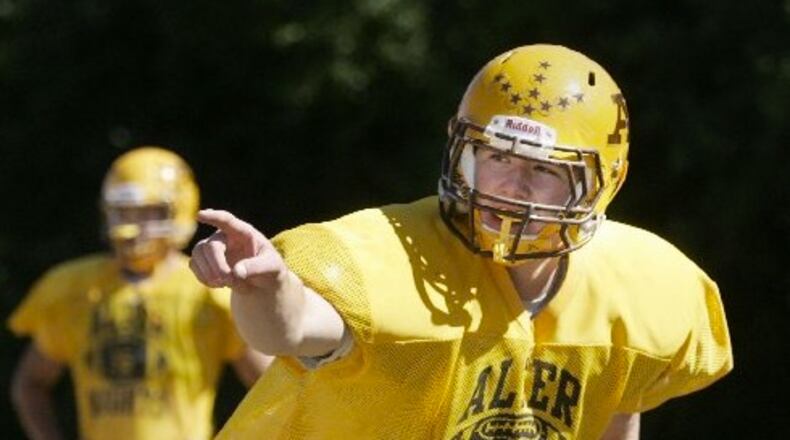»RELATED: How to watch Super Bowl LIII on WHIO-TV
Thuney's story is a reminder that a lack of early attention from recruiting analysts and college coaches certainly does not preclude a player from making it to the top.
While the blue-chip recruits, those uber-talents generally discovered as freshmen and sophomores in high school, might be the most likely to make it all the way to the pinnacle of the sport, there is room for everyone.
That includes those still scrapping for offers after they’ve played their last down of high school football, as was the case for Thuney.
Despite helping the Knights to a pair of state championships, Thuney was not a five-star, a four-star or even a three-star recruit at Alter High School eight years ago.
>>PHOTOS: Looking back at Alter's back-to-back state football titles in 2008-09
Credit: Chris Stewart
Credit: Chris Stewart
A two-star prospect, he was the No. 85 player in Ohio and 129th-rated offensive tackle in the class of 2011 according to 247Sports Composite rankings.
Recruiting rankings, while generally accurate in the big-picture sense in that the teams that recruit the best players tend to win more games and the higher-rated recruits are statistically more likely to be successful, have their limitations of course.
While measuring the physical ability of a player at 16 or 17 is not that hard, projecting how a prospect will develop over the course of four or five years is more of a challenge.
Sometimes the most physically gifted teenagers are still the best at 22, but that is not always the case.
Understanding what type of work ethic a player might have — not only now but, again, in the future — can be even more tricky.
That’s a challenge college coaches face, too, as evidenced by an anecdote Thuney’s father, Mike, passed along this week.
“We were back and forth with Ohio State and (head coach Jim) Tressel was like, ‘Well, I just don’t know, Joe, are you a tight end or a defensive end? Are you an offensive lineman?’ ” Mike Thuney recalled. "Joseph graduated high school at maybe 6-5, 240, so you had to have a little imagination.”
Tressel, who signed Alter standout Nick Mangold in 2002 and was famous for finding diamonds in the rough during his 10 seasons as coach of the Buckeyes, ultimately never came through with an offer.
Another major-college coach with roots in Ohio took advantage.
(As an aside, the 2011 Ohio State recruiting class ended up being one of Tressel’s best, but no thanks to its offensive linemen, none of whom panned out.)
Ohio State’s loss ended up being North Carolina State’s gain.
>>RELATED: Where Ohio State’s 2019 recruits rank
Wolfpack head coach Tom O’Brien, a Cincinnati native, sold the Thuney’s by telling them exactly how he envisioned Joe’s career in Raleigh turning out.
“He said, ‘This is what’s going to happen: We’re going to put you in, you’re gonna redshirt and get bigger and stronger and I’m going to make you a center and you’re going to play on Saturdays and probably play on Sundays, too,’ “ Mike Thuney said. “So we’re like, ‘All right, here’s a guy who’s got some vision so we went with it. It was cool.”
O’Brien wasn’t just blowing smoke to land a recruit. His vision came true, and Joe Thuney’s story — while unique — can serve as an example that a player’s football fate is far from sealed before his senior season, as it sometimes feels these days with the recruiting cycle having significantly shifted over the past decade.
Recruiting: The area’s top football prospects for 2020 https://t.co/ahtuPTRxAC pic.twitter.com/MZXBnhoUjB
— journalnews (@journalnews) January 30, 2019
Whereas junior-year commits were once rare, they are now the norm.
Those who wait until their senior seasons to decide where they will go tend to be the super elite prospects who have the best of the best to choose from — or players such as Thuney who need one last fall to impress convince future coaches they are Division I material.
“Think about how many offensive linemen were recruited before Joe Thuney,” Alter coach Ed Domsitz said. "I would love to have seen him go to Ohio State or Notre Dame, someplace around here, but it didn’t work out that way, and for Joe it turned out to be a great experience down at N.C. State.”
But that is still only half the story.
While lower-rated recruits find success in college all the time, their prospects in the NFL are another story.
That raw ability the recruiting services are measuring? It’s still essential to make it in the NFL.
Only the cream of the crop make it to the top — let alone become starters right away.
>>RELATED: More than a dozen local ties to the Super Bowl | Alter's Joe Thuney a stalwart for the Patriots
Thuney’s ascension is a reminder that development never stops — not at 17, 21 or 23.
Rated by NFL.com as a backup or "eventual starter," he ultimately surpassed those expectations, too.
“When you look at what Joe was able to accomplish once he got to North Carolina State, it came about as a result of his dedication and work ethic and just how smart he was,” Domsitz said. “He is a very coachable person, and he listens and then is able to execute or perform what the coaches would like him to do.”
Mike Thuney had nothing but good things to say about his son’s time at N.C. State.
After regularly trekking south to see their son play for the Wolfpack, he and his wife, Beth, have spent the past three seasons criss-crossing the country to follow his NFL exploits.
Not bad for a two-star recruit who could have been a college tight end.
“It was good experience to learn how everything works,” Mike Thuney recalled of the recruiting process. “It’s like anything else, one door closes and another one opens.
“It all worked out.”
About the Author


